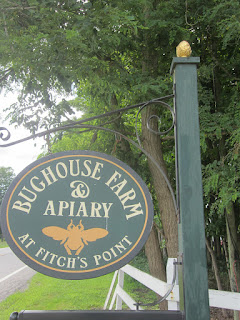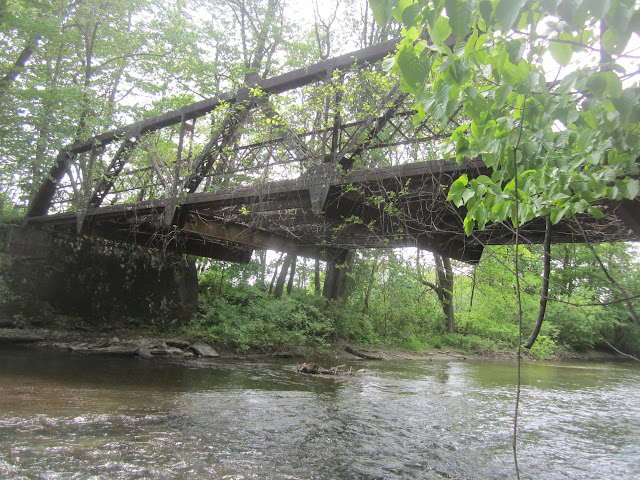Saw this story on VPR and passing on a link for anyone who missed it. While the public forest would be in Vermont its most convenient access could be from Blind Buck, Beatty Hollow or Chambers Road. With vision these Taconic hills along the border could become popular with equestrians, hikers and mountain bikers as well as history buffs. Other nearby counties are turning to their natural beauty and recreational potential to bolster their economies so why not here? Becoming a mecca for trail riding would create opportunities for farmers (hay, oats, straw) and entrepreneurs (guiding, rentals, lodging). It has become too easy to blame Albany for all of Washington County's problems. Manufacturing is leaving and public employment is unsustainable. Time to look for fresh opportunities.
Saturday, August 24, 2024
Thursday, August 8, 2024
The Bug Catcher
Anyone else feeling bugged?
As in, literally tormented by bugs. Happens every year about this time. As summer's heat and humidity build to a crescendo, so does the population of noisome insects. In the kitchen ants march two by two across the counter while house flies rule the ceiling above. Their cousins the deer flies (from the bad side of the family) turn a walk in the woods into torment. If you survive till evening there's no reward because mosquitoes will pester you when you try to sit outside. What's almost as bad is the guilt I feel for detesting the little beasts. Shouldn't a good naturalist appreciate all of nature?
My solution has been to spend some time with a great naturalist who loved all things 'bug'. His name was Asa Fitch and he lived in the 1800's near Salem. In fact, the site of his home farm is still called Fitch Point to this day. Obviously, he's not still around in the flesh but with his writings, books written about him and wandering where he once did you can get a good sense of the man. Let's hang out with Mr. Fitch and see if we can't change some of our bad attitudes toward Class Insecta.
First, a brief introduction. The Fitch's were English Puritans who first came to America in 1638. Around 1780 a Fitch moved to Salem, then known as New Perth. Eventually the family bought a farm that came to total 600 acres and included a mill site on the Battenkill. This is just beyond present day East Greenwich, on a point of land formed by the confluence of Black Creek and the Battenkill. Traveling on Rt. 29 today, the Fitch house is located opposite the Cargill mill. Note that there is a relatively (for Washington County) large level area here. This was formed as the glacier melted 13,000 years ago and gravelly outwash poured into a temporary lake. It has been farmed continuously since European people first settled here.
The Asa Fitch that we'll get to know was born in the large old house (now just visible thru the trees) on February 24, 1809. Both he and his father were named Asa and both were medical doctors which can lead to some confusion. The second generation Asa lived most of his life at Fitch's Point passing away in the same house he was born in on April 8, 1879. He was educated, first at a local school at Fitch Point, then at Washington Academy in Salem and later at the Rensselaer School in Troy (later to become RPI), finally receiving his medical degree in Castleton, Vermont in 1829.
Fitch practiced medicine for a few years in Fort Miller and Stillwater before returning to the family farm in 1838 to take over from his aging father. He soon gave up his medical practice to devote his energies to farming but still made time for his true passion which was nature study. While he was knowledgable in many areas of Washington County natural history (including geology) it was insects that he was most passionate about and that became his eventually claim to fame.
Fitch became something of a joke to his neighbors who called him 'The Bug Catcher' as they watched him on hands and knees searching for specimens. His office was known as 'the bug house' and it was filled with mineral specimens, dried plants, preserved animals and cases of collected insects. The building still stands today off to the side of the large main house although I don't know what became of his collections.
Agriculture was New York's major industry and by the mid-1800's it was recognized that inspect pests were causing large economic losses. At the same time Fitch's expertise was recognized in Albany and he was called upon to research damage in fruits and grains. His reports were so well done and helpful that he continued for many years as the defacto state entomologist with a salary of $1000.
What's impressive is that, while establishing entomology as a science in New York State, Fitch also had time to contribute the geology section to Crisfield Johnson's 1878 History of Washington County, New York and to collect oral histories from elderly friends and neighbors that totaled into hundreds of pages of memories dating back to the earliest days of settlement. All this while running a large diversified farm. As the saying goes, "They don't make them like they used to."
You can visit Fitch's grave at Evergreen Cemetery just a few minutes from his home towards Salem. The monuments inscription reads:
Asa Fitch
Physician and Naturalist
Eminent among compatriots:
Fame had not the power to win
from him humbleness of spirit,
purity of soul, modesty of
demeanor, charity and love
for his fellow men.
And, I might add, love of nature. Even (especially) bugs.
MORE...
Friday, August 2, 2024
Walk This Way
Ready for a nice walk?
It goes thru the scene of disastrous fires, past some ruins, between a couple of dumps, along a chain link fence topped with barbed wire. There's even a long uphill slog on the return. Real nice.
Since I'm not in the business of tourism promotion I get to tell it like it is. But wait, this is way better than it first sounds. Actually, one of the most popular strolls in all of Washington County. It was once the favorite pastime of a highly celebrated poet.
We'll start on Pearl Street in Hudson Falls. Should be ok to park in the American Legion's large lot. Be sure to take a moment to thank the veterans for their service and pause at the 9/11 memorial near the entrance, 'lest we forget'. From there head back towards downtown a short ways to admire the large yellow Victorian house set amid beautiful gardens. It's for sale as of this writing. This is 57 Pearl Street , the former home of William Bronk. He was a local boy who made good with his many volumes of poetry. In 1981 he won the National Book Award for Life Supports: New and Collected Poems. He also ran the family business, Bronk Fuel and Lumber, while being noted as a great cook and host and an indefatigable walker.
In fact, he never drove and that was how I got to meet him. Many years ago, maybe in the '80's, I dropped in on a poetry discussion group at Crandall Library. As closing time approached a tall, stern man whom the others clearly revered stated, "Drinks and further reading at my place". Then he looked at me and said, "I'll ride with you." I didn't have a clue who he was but felt a sense of honor and confusion at being chosen as his driver. We chatted on the short hop to Hudson Falls and then hung out with others in the big house at 57 Pearl Street.
It wasn't till later that I learned more about Bill Bronk and surmised that he was hoping to find someone as passionate about words and ideas as he. Unfortunately, it wasn't me at that time and I never saw him again, but I'll always cherish my memory of driving (and disappointing) the great poet. Maybe if we'd went for a walk together there would have been a better connection.
I can imagine Bronk bounding off the porch of Big Yellow and striding out Pearl Street to a right on the feeder canal towpath. This was his favorite route and it will be ours as well. Across the road are the many buildings of Griffen Lumber with the landmark coal silos visible beyond. Definitely worth checking them out.
The towpath here provides a pleasant shaded walk on hot summer days. The sound of running water as it rushes thru old Lock 12 makes it feel cool. Across the canal was where the sprawling Kenyon Lumber Company once stood. The American Legion now occupies one of its former buildings. In a game of musical sawmills, Griffen bought Kenyon in 1926 and moved equipment over Pearl Street to its location. A fire in 1932 destroyed a remaining Kenyon building and another of its mills was dismantled. Today what you see are a few foundation stones and the backyards of residential development.
The towpath soon crosses Burgoyne Avenue and drops down past a parking area, picnic spot and the Five Combines locks. The capped Kingsbury landfill is on the left with its ugly fence, courtesy of liability lawyers. Off to the right, screened by trees, is its sibling the Fort Edward landfill.
As you walk downslope you are dropping off a sand and gravel delta built up by the ancestral Hudson River and entering the clay bottomed floor of glacial Lake Albany. Abundant water and cover make this a good spot for birding and botanizing. It is said that Bronk could identify every flower and bush along the path. The locks and towpath here provided inspiration for several of his poems.
At the bottom of the hill the towpath levels out and crosses a bridge at a T intersection. This is where the poet liked to swim nude with his friends at 'Bronk Beach'. It was also a dark sky place for late night stargazing. The Feeder Canal empties into the old Champlain Canal here and that in turn joins Bond Creek before flowing into the modern Barge Canal. What used to be just 'the towpath' is now the Empire State Trail. If you feel like walking a little further you can go to Canada, New York City or Buffalo from here. Otherwise it's a good place to turn around and retrace your steps back uphill.
BRONK REVISITED
I'm not sure how much Bronk gets read anymore. His work isn't as easily accessible as say, Robert Frost's or Mary Oliver's. It can be rather dense, dark and challenging. In this Instagram/Facebook era of 5 second attention spans his poetry is not for everyone. You have to work to get it and then you might end up depressed for your effort.
If you are up to the task check out the Village Booksmith which may have some used copies of his poetry on their shelf. Across the street the Hudson Falls Library has a memorial to him out front and a small collection of his work inside (look in the far back corner). While in Hudson Falls you might also want to visit his grave in Union Cemetery where there is a plaque dedicated to his life and achievements. Finally, as I sometimes do, you can park in front of the the grand old manse at 57 Pearl Street and read the poems where they were written.
.webp)
.webp)






































